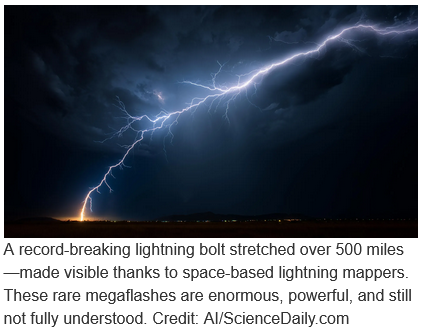Researchers used space-based instruments to measure a record-setting 515-mile lightning bolt that lit up the skies from Texas to Kansas City, smashing previous records.
Thanks to advanced satellite technology, scientists like Randy Cerveny, an Arizona State University President’s Professor in the School of Geographical Sciences and Urban Planning, and researcher at Georgia Tech Research Institute Michael Peterson, are uncovering the mechanics of “megaflash” lightning—rare, colossal discharges that span hundreds of miles across the sky. These massive bolts, emerging from long-lived, sprawling thunderstorms, pose real danger even when skies seem clear.
“We call it megaflash lightning, and we’re just now figuring out the mechanics of how and why it occurs,” said Cerveny.
The megaflash took place during a major thunderstorm in October 2017. Its horizontal reach surpasses the previous record of 477 miles, set during an April 2020 storm in the southern U.S. by 38 miles.
The new record-setter went unnoticed until a re-examination of satellite observations from the 2017 storm.
“It is likely that even greater extremes still exist, and that we will be able to observe them as additional high-quality lightning measurements accumulate over time,” said Cerveny, who serves as rapporteur of weather and climate extremes for the World Meteorological Organization, the weather agency of the United Nations.
For years, lightning detection and measurement relied on ground-based networks of antennas that detect the radio signals emitted by lightning and then estimate location and travel speed based on the time it takes signals to reach other antenna stations in the network, the researchers explained.
Satellite-borne lightning detectors, which have been in orbit since 2017, have enabled the continuous detection and accurate measurement of lightning at continental-scale distances.
“Our weather satellites carry very exacting lightning detection equipment that we can use to document to the millisecond when a lightning flash starts and how far it travels,” Cerveny said.
Parked in geostationary orbit, the National Oceanic and Atmospheric Agency’s GOES-16 satellite detects around one million lightning flashes per day. It is the first of four NOAA satellites equipped with geostationary lightning mappers, joined by similar satellites launched by Europe and China.
“Adding continuous measurements from geostationary orbit was a major advance,” Peterson said. “We are now at a point where most of the global megaflash hotspots are covered by a geostationary satellite, and data processing techniques have improved to properly represent flashes in the vast quantity of observational data at all scales.”
Peterson is the first author of a report in the Bulletin of the American Meteorological Society documenting the new lightning record.
Most lightning flashes are limited to less than 10 miles in reach. When a lightning bolt reaches beyond 60 miles (100 kilometers to be exact), it’s considered a megaflash.
Less than 1 percent of thunderstorms produce megaflash lightning, according to satellite observations analyzed by Peterson. They arise from storms that are long-lived, typically brewing for 14 hours or more, and massive in size, covering an area comparable to the state of New Jersey.
The average megaflash shoots off five to seven ground-striking branches from its horizontal path across the sky.
While megaflashes that extend hundreds of miles are rare, it’s not at all unusual for lightning to strike 10 or 15 miles from its storm-cloud origin, Cerveny said. And that adds to the danger. Cerveny said people don’t realize how far lightning can reach from its parent thunderstorm.
Lightning kills 20 to 30 people each year in the U.S. and injures hundreds more. Most lightning strike injuries occur before and after the thunderstorm has peaked, not at the height of the storm.
“That’s why you should wait at least half an hour after a thunderstorm passes before you go out and resume normal activities,” Cerveny said. “The storm that produces a lightning strike doesn’t have to be over the top of you.”
Arizona State University. (2025, August 1). 515-mile lightning flash caught from space. ScienceDaily. Retrieved August 1, 2025 from www.sciencedaily.com
